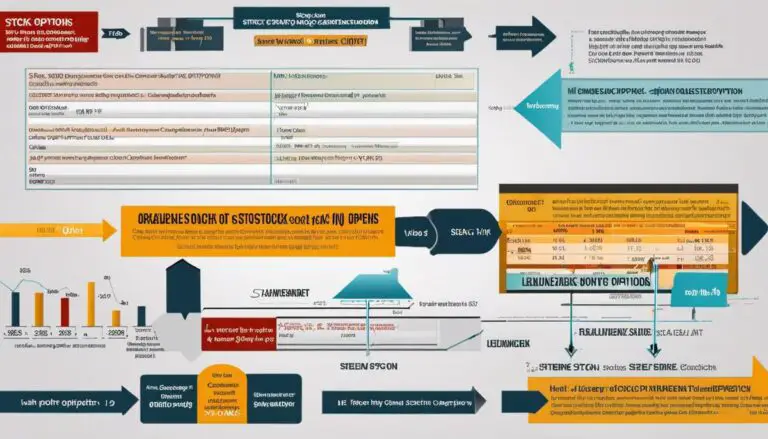Options trading, a branch of finance that involves the buying and selling of options contracts, is a powerful tool that can generate significant profits when used wisely. However, it can also pose considerable risks if not understood properly. This discourse delves into the intricacies of options trading, offering an in-depth exploration into its terminologies, types of contracts, strategic methods, and the vital area of risk management. Emphasizing the necessity of an informed approach, the aim is to equip the reader with the essential knowledge required to navigate the complex but rewarding world of options trading effectively.
Understanding Options Trading
Options trading, an intriguing, dynamic, and potentially lucrative sector of the financial sphere, could be the game-changing addition your investment repertoire needs. Turning a blind eye to this innovative trading arena might be an inadvertent self-inflicted stumbling block on the path to financial success.
To put it simply, an option is a contract that allows the potential to buy or sell an asset, frequently stocks, at a predetermined price, on or before a specific date. This flexible financial instrument comes with two categories: call option and put option.
In essence, a call option grants the right (but not the obligation) to buy an asset at a set price within a particular timeframe. Conversely, a put option offers the right (without obligation) to sell an asset at a predetermined price within a specified period.
The real beauty of options trading lies in its duality of purpose. It not only provides a hedge against potential market downfalls but also offers the opportunity to speculate on future price movement, with potentially stellar returns.
This speculative aspect is an enthralling facet of options trading. Imagine predicting a stock’s valuation surge before a major product launch or financial report. Purchasing a call option allows the speculation to reap profit if the forecast comes to fruition, all the while mitigating the risk of direct investment in the stock.
Equally enticing is the hedging element of options trading. We all appreciate the necessity of a safety net in life, especially so when it involves our hard-earned capital. As investors, staying protected against market downturns is never a disregardable priority. Options trading provides such a hedge. By purchasing a put option, an investor can lock in a selling price, guarding against a potential fall in stock price.
Though options trading can be a dynamic addition to your investment portfolio, it requires a thorough understanding of the markets and ceaseless diligence. The steep stones of risk and reward can be slippery. The potential for high gain is counterbalanced by equally potent risk. However, with careful planning and strategic execution, option traders may unlock a new dimension of investment success.
Ultimately, options trading is an innovative, flexible, and potent tool in the increasingly diverse investment landscape. It can be an integral part of a well-rounded, flexible, and broad-based financial strategy, which is an invaluable asset in itself. So, whether for hedging, for speculation, or just for adding diversification, options trading provides a compelling case for its spot in any savvy investor’s repertoire.
Expand your domain, dare to innovate, and step boldly into the realm of options trading – where risk and reward reside side by side.

Types of Options Contracts
Riding the wave of innovation and the shifting dynamics in the financial markets, let us delve into the complex but fascinating world of options contracts. We’ve already set the table by exploring the fundamentals of options trading, the allure of call and put options, the significance of this versatile financial instrument and the rewarding, yet challenging nature of its market terrain. Now, it’s time to navigate the profound spectrum of options contracts, and unpack the texture of their varied structures.
Conventional options tend to flood the common markets, yet there’s an expansive category of options known as ‘Exotic Options’. Unlike their traditional counterparts, exotic options can drastically alter the risk-reward profiles, offering the creative and astute business person new horizons to explore.
Exotic options can be broadly classified into ‘Path Independent’ and ‘Path Dependent’ types. Path independent options, including ‘Compound’, ‘Chooser’, and ‘Barrier Options’, resonate with the shapeshifters of the business world. They pose a variety of strike price conditions, offering versatility in taking or dodging market risks.
Compound options, in fact, add a touch of abstraction: an option on an option, tempting those who love a gamble within a gamble. Barrier options, on the other hand, spring surprises by activating or deactivating only when the underlying asset crosses a predetermined price level. Chooser options are for those who love to keep their options open: the choice between buying a put or a call option, made at a later date.
Path Dependent options, which include ‘Lookback’, ‘Asian’, and ‘Rainbow Options’, provide an edge for those with a keen anticipatory vision. They base their payoff on multiple price points throughout the contract’s life or the performance of multiple assets.
‘Lookback’ options eliminate the guessing game by providing the luxury of hindsight, enabling the holder to ‘look back’ over the option’s life and select the optimal price. In ‘Asian’ options, the average price over a certain period determines the payoff, adding a buffer against market volatility. ‘Rainbow’ options are for the ultimate multi-tasker, as they hinge on the performance of two or more assets.
Lasty, let’s pull the curtain back on ‘Binary Options’, which are rather straightforward and appeal to those who are drawn to the simplicity of a win-lose scenario. The payoff is a fixed amount or nothing at all, turning the trade into a simple prediction of the market direction.
In conclusion, it’s evident that the vast array of options contracts and their intricate structures reflect the constant innovation and evolving nature of our financial markets. These contracts cater to a broad spectrum of risk appetites and strategic preferences, providing a thrilling arena to play in for the alert, adaptive, and forward-thinking entrepreneur. As always, wisely navigating this complex landscape depends upon sound financial knowledge, disciplined research, and a dash of daring innovation. So, let’s progressively embrace these financial tools in pursuit of a perfectly balanced financial strategy without fear and hesitation.

Options Trading Strategies
Pivoting the discussion towards the focus of this piece, it is imperative to underscore the strategies employed by investors to capitalize on opportunities presented by options trading. These strategies require a blend of shrewd business acumen, robust market comprehension, and grit to take those calculated risks.
Notably, a widely used strategy is the ‘Covered Call’. This approach is typically deployed by traders who have a neutral opinion of the market, i.e., they believe it will experience minor fluctuations in the near term. By selling call options on a security they own, they generate income via the premium paid by the buyer of the call option. This effectively creates a buffer against minor losses should the security’s price drop.
Seizing the present scenario, markets fluctuating owing to global dynamics and unpredictable economic shifts, the ‘Long Straddle’ strategy has gained immense traction. A trader employing this strategy buys a call and put option on the same underlying asset with similar strike prices and expiry dates. This allows them to profit from large price movements, regardless of the direction.
Moreover, the ‘Protective Put’ strategy, viewed as an insurance policy by many, is an effective risk management strategy. This involves buying put options for an already owned stock to protect against a potential drop in its price. So, even if the market moves against their position, the put option will increase in value, offsetting the loss in stock value.
Innovation in financial markets has introduced ‘Options Spreads’, a sophisticated form of options trading where traders buy and sell two or more options contracts simultaneously. This can further be divided into ‘Vertical’ and ‘Horizontal Spreads’, both of which serve distinctive market perspectives and risk management profiles.
Vertical Spreads involve buying and selling options of the same type and expiry date but at different strike prices and are ideal in a market with expected moderate movements. Horizontal Spreads, also known as Calendar Spreads, involves options with different expiry dates but the same strike price. It capitalizes on the time decay factor inherent in options and perfectly fits in a stagnant or mild fluctuation market scenario.
Embracing these strategic methodologies paves the way for financial growth in the dynamic terrain of options trading. Their effective implementation depend on traders’ proficiency in reading the market and their deftness in navigating through potential high-tide situations.
Successful options trading, beyond the realm of typical investing, represents the essence of modern business agility: the willingness to innovate, the confidence to take calculated risks, and the wisdom to strategically balance between optimism and caution. Perhaps then, it is not merely a financial mechanism but a strategic embodiment of entrepreneurial spirit, ensconcing itself significantly in the high-octane world of global finance.

Risk Management in Options Trading
Managing Risks Effectively in Options Trading: Strategic Methodologies for Steady Growth
Strategic navigation seeks to elevate your game in the options trading landscape. One well-defined approach involves using covered calls, a strategy deployed by investors seeking income from a stock investment. Essentially, a covered call strategy involves selling call options on stocks one already owns, offering limited downside protection in exchange for limited upside profit. This approach is favorable in slowly rising or steady markets, as it allows you to earn a premium on your stock holdings.
Another efficient strategy is the long straddle, an excellent weapon for unpredictable markets. The strategy involves buying both a call and a put option for the same underlying asset, strike price, and expiration date. This maneuver ensures profit regardless of drastic swings in the price of one’s investments.
In times of uncertainty, consider implementing the protective put strategy. This involves buying a put option on a stock you already own, reducing the risk of owning the stock while maintaining the potential for upside gains. The protective put acts as insurance, granting you the right to sell your stock at a predetermined price, mitigating potential losses and allowing the luxury of participation in any upside movement.
Options Spreads, another strategy, allows the simultaneous buying and selling of two or more options differing in at least one of the options’ variables. This can provide more than one way to profit or can simply be used to limit risk.
Within the overall concept of options spreads are vertical and horizontal spreads. These articulate well-defined strategies within the world of options trading. In vertical spreads, trades are executed on the same underlying security, same expiration date but different strike prices. On the contrary, horizontal spreads involve trades undertaken with the same underlying security, same strike prices but different expiration dates.
Embracing these strategic steps will foster financial growth. We must learn from markets that flow like rivers, sometimes placid, sometimes raging, yet always moving forward. Reading these currents for the faintest signs of change—the slightest shifts in patterns and trends—will gear you to encounter waves of volatility.
Such agility in the world of business, particularly in options trading, involves taking calculated risks while riding out storms. The ability to adapt and improvise requires being vigilant about current and future market trends and leveraging new technologies to keep pace with innovation.
Modern business should bathe in agility, moving with the pace of rapid evolution while keeping one’s risk tolerance in check. As such, entrepreneurial spirit—one that thrives in innovation and foresight—is a necessity in the dynamic landscape of options trading.
Options trading is not an area to be feared but rather to be respected. It provides sharp tools for savvy investors who have learned to harness the power of this complex yet rewarding world. To that end, staying ahead in the game will call for an innovative approach, entrepreneurial spirit, and perennial learning.
In conclusion, the world of options trading is like a chess game. It requires strategic moves, foresight, and the ability to swiftly adapt to changing circumstances—a combination that thriving entrepreneurs already possess.

The diverse environments of financial markets call for versatile tools capable of offering opportunities for profit while providing protection against fluctuating scenarios. Options trading is a powerful weapon in the arsenal of an astute investor, operating as a dual-edged sword for hedging and speculation. However, any foray into the realm of options trading should be embarked upon with a clear comprehension of fundamental concepts and strategies, blended with a sound risk management plan. Mastering these elements can pave the path to a profitable and secure trading journey in the bustling lanes of options markets.



